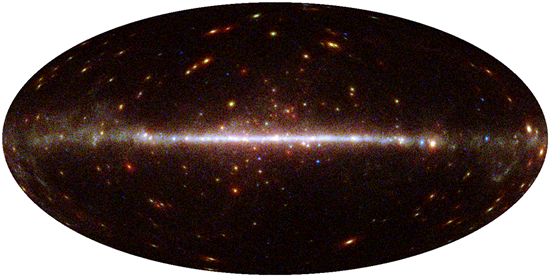Sources and Simulated Data for DC2
Last updated: 06/02/2006 09:17:39 AM
Pointing/attitude history
The pointing history (FT2 file) was generated using a realistic (or at least approximately so) orbit and attitude profile for a circular, 565 km orbit. It spans 55 days, approximately 1 precession period for the 28.5 deg inclination of the orbit. Actually, for technical reasons (gtbary not wanting to correct times that are right at the end of an FT2 file), the file is actually 55 days + 1 minute long.
The start of the observation is midnight (UTC), January 1, 2008. The times in the FT2 file are Mission Elapsed Time with respect to January 1, 2007 (MJDREF = 51910.0).
The simulation includes time lost to SAA passages (13.9%), and a new entry is started whenever the LAT enters or exits the SAA. The definition of the boundary of the SAA was calculated by Rob Cameron. Because the SAA is in the south (surprise), the overall effect of SAA outages is to cause a deficit of exposure at southern declinations, amounting to ~30% near the southern pole, relative to exposure in the north. (In actual operation, the observing strategy may be modified to increase the dwell time for southern rocking, but that was not done for DC2.)
The FT2 file also includes a realistic live time calculation for each time interval, based on the trigger rate as a function of geomagnetic latitude. The overall average live time fraction is 93.4%, ranging from 80.0% to 95.2% for time intervals outside the SAA. The overall live time fraction during DC2 is (1-0.139)*0.934 ~ 80.4% (3.82 Ms).
Sky Model
1719 discrete sources were simulated in the DC2 sky (in addition to several diffuse sources and transient sources). We have created a directory containing ascii tables of the DC2 source lists.
The sky model is in several XML files and supporting FITS and ASCII files. Almost all of the files that you will need to run the sky model yourself in gtobssim or Gleam, should you want to are here. For the pulsar sources, you will need to set the environment variable PULSAR_DATA. The jobptions fragment that we used to define the fragment can be found here.
We have made a fits file containing the FT1 data for the 55 day duration of DC2 which includes an additional variable called MC_SRC_ID. Each source is assigned an MC_SRC_ID, you can use this to select photons produced by individual sources.
Blazars 204 flaring blazars are included in the sky model. 104 are assigned positions and fluxes consistent with EGRET 3EG sources. The light curves are artificial (of course).
In addition to the flaring blazars, 905 isotropically distributed faint (i.e., below the EGRET flux limit), steady blazars were included in the source model. These may be identical to the faint blazars that were included in the DC1 data. In terms of equivalent isotropic intensity, they amount to less than 10% of the EGRET isotropic background.
Pulsars Six EGRET pulsars, with ephemerides, spectral, and light curves consistent with the EGRET observations, were included, 39 phony pulsars that are coincident with unidentified EGRET sources, 17 randomly generated radio-loud ms pulsars, 212 randomly generated ms radio quiet pulsars, 37 randomly generated normal radio-loud pulsars and 103 randomly generated normal radio quiet pulsars
An ephemeris file from gtpulsardb for the timing parameters of all 414 of these pulsars is available. This is useful, e.g., for gtpphase and gtpsearch. The ephemeris for each pulsar is defined for the entire time span of DC2 and the timing parameters are absolutely perfect. That said, some of the EGRET pulsars have an arbitrary phase offset specified that makes the generated light curves shifted with respect to the TimeProfile specifications. If you don't like this, finding and removing the shifts with fv would take about 1 minute.
Supernova Remnants 11 SNRs were included, these are a mix of point and extended sources. The extended sources are modeled HESS SNRs with spectra extrapolated (optimistically) to LAT energies.
OB associations - 4 of them
High Latitude Molecular clouds - 40 of them.
Plerions - 7 of them
Galaxy clusters - 4 of them
Galaxies - 5 of them
X-ray binaries - 5 XRB's were included in the DC2 sky. 3 of them were defined as periodic sources and two were variable sources.
Other 3EG For completeness, the 120 real (not known to be spurious), non-solar flare 3EG sources not already accounted for above were included at their 3EG positions and with their 3EG fluxes (or possibly somewhat less). The XML definition file is included with the others, described above.
GRBs 132 bursts were simulated over 4 pi, 64 of these were detected by the GBM. The reasons for non-detection by the GBM included Earth occultation, SAA outages, below GBM flux threshold (6e-8erg cm-2). 9 of these GRB had afterglows (two of the GRB with afterglows did not have a GBM detections).
| Owned by: | Julie McEnery |
